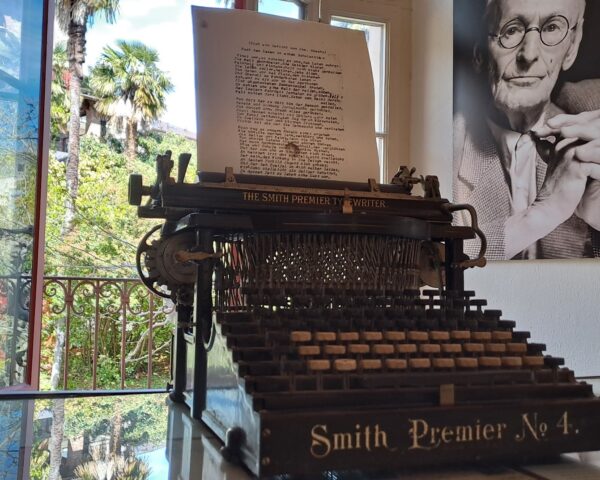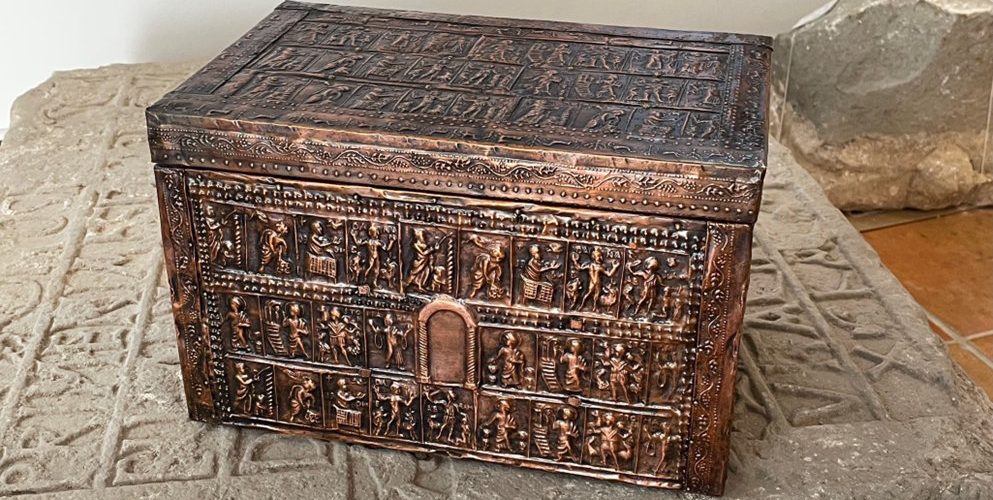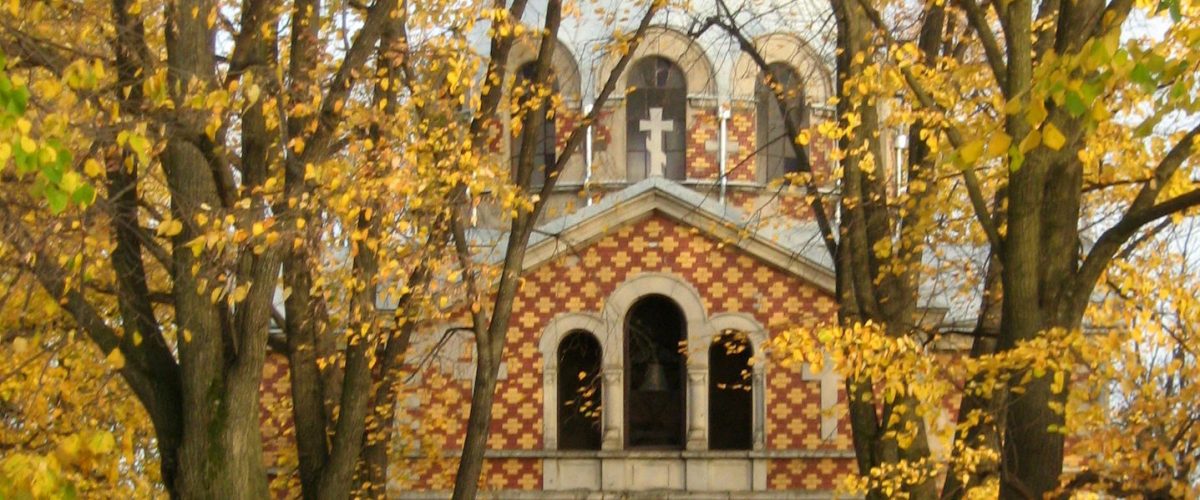TRACES OF ANNA KARENINA’S COLONEL
By Zoran Stevanović and Siniša Golubović
Colonel Nikolai Nikolayevich Rajevsky was a Russian volunteer who came to the rescue of Serbia during the First Serbian-Turkish War (1876-1877), with about 3,000 other Russian volunteers, during Serbia’s heroic struggle for the liberation of the Serbian people and territory under Turkish rule.
On the last dramatic pages of “Anna Karenina”, after the Bible the most translated work of world literature, Vronsky (Rajevski) goes to the Serbian-Turkish war. Tolstoy’s hero felt that he would not return from that war, so, leaving by train with hundreds of Russian volunteers, he boldly stated that he did not need a recommendation to die. His journey to Serbia started in Odessa, where he was on July 21, 1876, waiting for his resignation and wanting to travel to Serbia as soon as possible.

It is not known when Colonel Rajevski arrived in Serbia, but it must have been before August 1 (12), 1876, because on that day, Prince Milan issued a decree making him a cavalry colonel of the Serbian army. The decree reads:
“His Highness our Lord and Prince Milan M. Obrenović IV, approved the proposal of the Minister of Military, with his excessive decree from August 1 only, to solve: The former Imperial Russian colonel Nikola N. Rajevski and the former Imperial Russian lieutenant Konstantin Aleksić were accepted into the civil service as contractual, the first as a cavalry colonel, and the second as an infantry captain of the II class.”
The writer Pera Todorović, a scribe and translator in the headquarters of General Chernyaev, the commander of the Morava army, left a testimony about Rajevski’s arrival on the Moravian front. In his diary from Saturday, August 14, from the camp at Prugovac, Todorović wrote: “Along the road to Prugovac, Colonel Rajevski arrives from somewhere. He arrived from Russia 10-15 days ago, and when he first reported to the headquarters in Aleksinac, I welcomed him. But when I handed over his business card to Chernyaev, it seemed to me that this arrival did not make the general as happy as he was looking forward to the arrival of other Russians.”
When Colonel Rajevski arrived on the Moravian battlefield, the Turkish offensive was in full swing. He was already sent on August 9 (21) near the village of Mrsolja (Moravca) on the left bank of South Moravia, on positions that were the most vulnerable. To reinforce the far right-wing, more battalions combined with one squadron and one battery under Russian Colonel Rajevsky also came to the battlefield as a volunteer that day.
Doctor Vladan Đorđević also left a valuable testimony about Colonel Rajevski’s stay on the Moravian Front. He notes: “I went from the hospital to the main headquarters, which I found in the evenings. At the table, many young Russian officers had come from Russia during my short absence and had been kept at the headquarters as orderly officers. As soon as I sat down, the door opened, and a tall, slightly stooped, black-haired officer in the worn uniform of a Serbian colonel with a divisional whip. On his right shoulder hung a Circassian saber on a thin belt, and on his chest, he had two Russian orders (one was the Order of St. Vladimir with swords).”
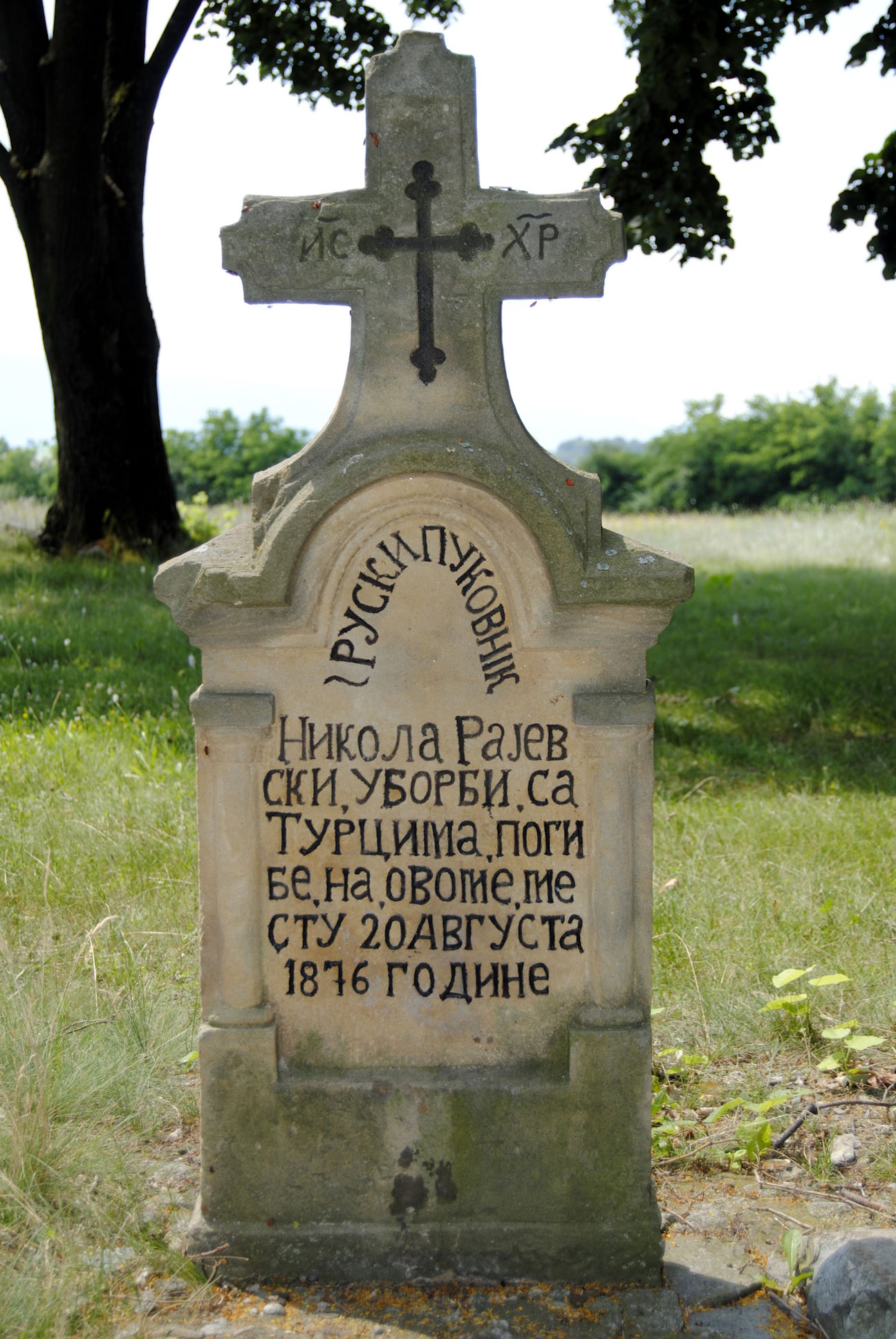
Stone at Colonel Rajevski’s place of death in Serbia
Regarding his death, Captain Kosta Šamanović submitted a detailed report to General Chernyaev. The report reads:
“On August 20, we had a battle with the Turks in the vineyards of Prcilova near the villages of Suhotno and Adrovac. At 2 p.m., I set out with the battery from Suhotna and took the position of higher Gornje Adrovac. There I found myself with Lieutenant Nikola Rajevski, who, together with our officers and popular commanders, was putting the disorganized mining brigade in order. Having completed that work, Rajevski ordered all the drummers and buglers to give the signal to charge, and thus the battle began under his command, with Rajevski taking up a position on the opposite side of the field. There was a convenient position in that field where I placed my battery. As soon as I opened fire, Rajevsky came to my battery; I told him who I was and what the battery was. He thanked me for that and asked why I was so close to the enemy with the battery. Rajevski stood in that position for the entire duration of the fight; he commanded that wing of ours. At around 4:00 in the afternoon, he was hit in the head by an enemy bullet and Rajevski fell dead without being able to utter a single word. It happened in the battery itself. I immediately ordered my soldiers to take the dead Rajevski to the rear to the marshaling ground. Rajevski did not have a single adjutant with him. During the fight, his horse was also wounded. His things, like a saber, Russian and Serbian orders, and other things with a horse, I sent a list to General Chernyaev.”
The death of Colonel Rajevski was recorded in the war diary of a second-classman. It states, among other things: “…Our battalion is in the vineyards below the trenches of Prcilovački, but since the battery is isolating itself, it has reached the outskirts of Krevet and Šiljegovac this evening with a deviating chain. The troop commander of the entire position, Prince Rajevski, died at the cannon and was taken to St. Novel. From the dressing room, along with the findings of Dr. Hadan, the body was handed over to the Main Headquarters, from where it was taken the next day, i.e., on August 21, and transferred to the Sveti Roman monastery and buried there, temporarily. But there is a legend that his heart remained forever in that first grave. For the return to his homeland, the body of Nikolay Rajevsky was exhumed, and at the request of Kesjakov, it was embalmed. The operation was performed by his friend, Bulgarian volunteer Doctor Molov. Then it was placed in an oak chest, then in another—a lead one, and finally shipped to the Serbian capital. The process of embalming, as it is known, involves the extraction of internal organs, which remained at the place of the first burial, so the grave in St. Roman is truly not empty.”

St. Roman Monastery, first grave of Colonel Rajevski
Ana Rajevska’s mother also came to Serbia to pick up her son’s body. When she arrived in Belgrade, she wanted to go to the place of his death in Gornji Adrovac. However, that was impossible because the Turks had already occupied that place. As it was not possible for her to travel to Gornji Adrovac, Ana Rajevska welcomed her son’s body in Belgrade. On September 5, 1876, responding to the condolences of the citizens of Belgrade, she said: “Thank you, gentlemen, for the condolences you express to me on the occasion of the loss of my son, thus showing respect for his memory. This was my son’s long-standing wish: he had long cherished in his heart the desire to sacrifice himself for the liberation of the Slavs and the expulsion of the Turks from the Slavic lands. Thank you again for your condolences.”
For Colonel Rajevski, the journey home began on September 1, at 11 am, according to the statement of the correspondent of New Times, his body was taken out of the grave and, after all the necessary preparations, was escorted from the monastery of Saint Roman with bells, at 11 a.m.
“Serbian newspaper in the issue of September 6 carries the following article: ‘Yesterday at 11 a.m., there was a memorial service for the soul of Colonel Nikola Rajevski, who died fighting bravely on the 21st in color under Adrovec. The memorial service was also attended by His Highness Prince Milan, Mr. Metropolitan with many clergy and deacons. On that occasion, the Metropolitan mentioned the great participation of the Russian people in our holy struggle. That speech was short, but powerful and enthroned everyone. The remains of the deceased were brought from the interior on Saturday, where the mother of the deceased, the widow of General Rajevsky, had come a few days ago to escort them from here to Russia.”
From the Sava pier, the ship Deligrad, the same one that only a month before brought the living Rajevski from Belgrade to Smederevo, now took him dead, accompanied by the thunder of cannons, to Odessa. From Odessa, he was transported by train to Funduklejevka station, in the county town of Aleksandrovki. And from there the crows, decorated with funeral ribbons, quickly brought the body of Colonel Rajevski to the family estate in Razumovka.
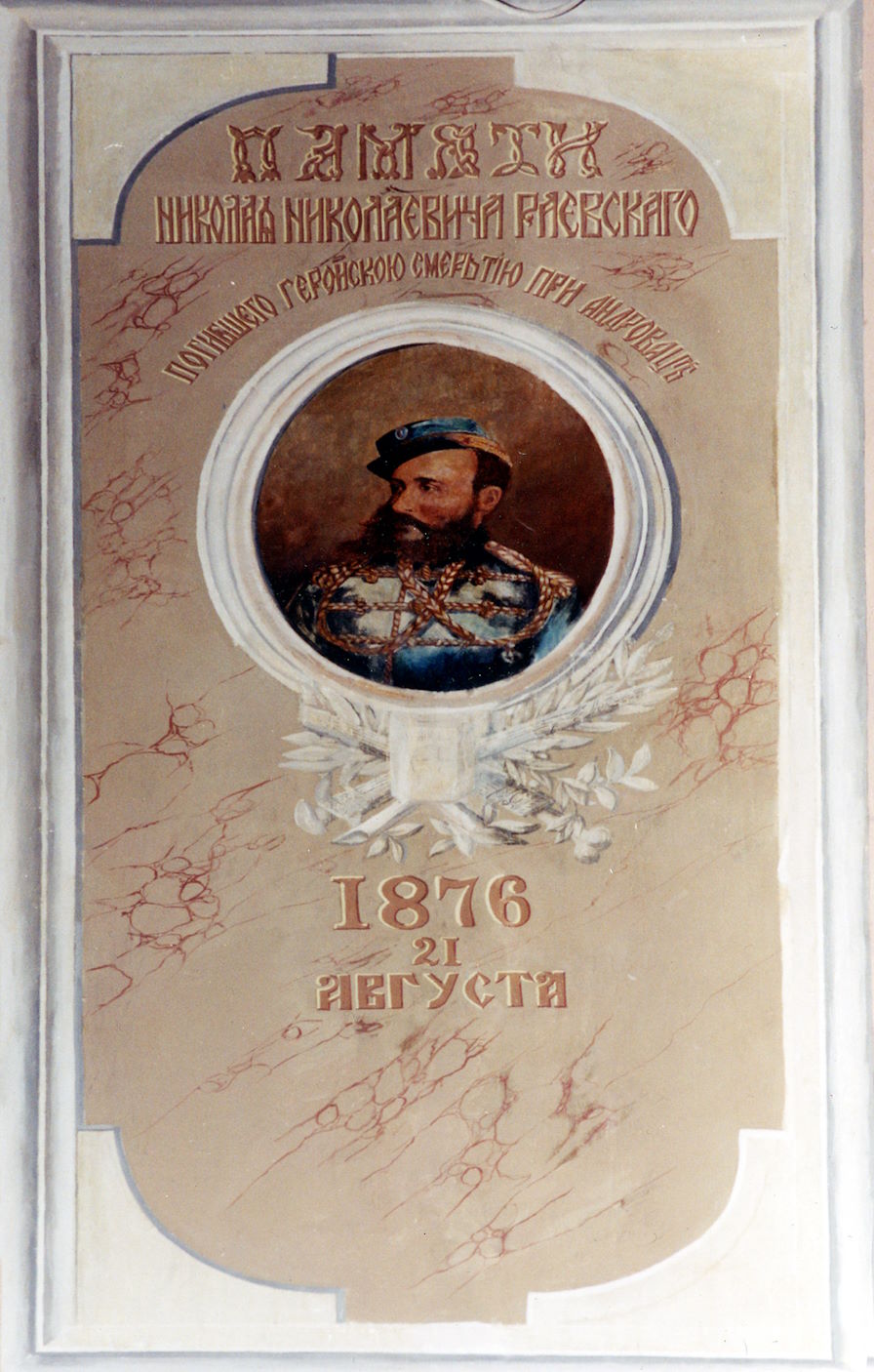
Grave at Razumovka
The coffin with the body of Colonel Rajevski was laid in the crypt of the Krestovozdviženska Church—the family tomb of the Rajevskis. The funeral took place on September 23 with the participation of the priest of the Church of the Ascension, Andrej Nesterovski, and the deacon of the church, Jevlampi Osinski.
The idea of building a temple monument at the place of death of N. N. Rajevski came from his mother, Ana Mihajlovna, during her stay in Belgrade, where she traveled for the body of her firstborn. But it took almost three decades to come to fruition. Seeing the impossibility of realizing her idea of building a church at the place of Nicholas’ death and feeling the approach of death (which followed on December 10, 1883), she asked her younger son to fulfill her vowed wish, leaving 50 thousand rubles for it. However, the complex and unfavorable political situation in Serbia at the time did not allow the dream to come true.
In October 1893, Mihajlo Nikolaevich died, handing over the family estate obligation to his older son, Nikolaj Mihajlovich. But he also died after a few years (in May 1900). At that time, the widow of Mihail Nikolaevich, Maria Grigorievna Rajevska (née Princess Gagarina), took over the fulfillment of her late mother-in-law’s will. She fulfilled the vow. She succeeded to a large extent because the attitude of official Belgrade towards Russia and Russians changed for the better.
The place where Colonel Rajevski died was originally marked at the beginning of August 1887 with a modest sandstone cross. For more than a decade, this was the only landmark that resembled the legendary hero. Then, the realization of the wish of Colonel Rajevski’s family started, and his death is now commemorated by the church.
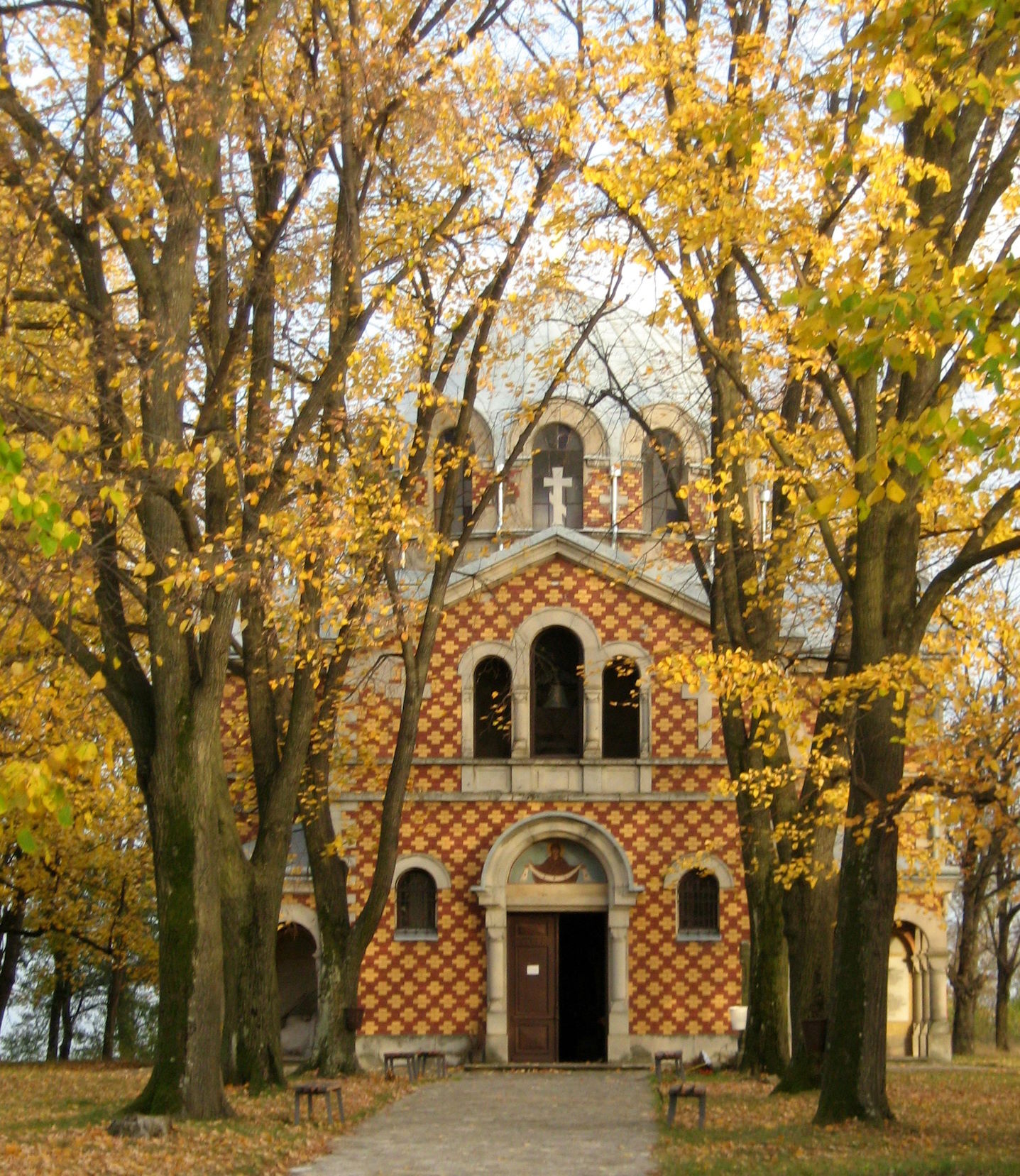
Church of the Holy Trinity, Gornji Adrovac, dedicated to Colonel Rajevski
Today, in Gornji Adrovac, a village twelve kilometers southwest of Aleksinac, there is the Church of the Holy Trinity dedicated to Colonel Rajevski. The church is located on an impressively raised plateau that dominates the whole area, which before its construction was called “Golo brdo” (Baren Hill). The area around the church is filled with trees that dominate from the road to the entrance to the church, rows of linden trees which, according to tradition, were brought from the village of Razumovka in Ukraine from the past estates of the Rajevski family.
Proposed tour of the route:
– Tour of the monastery of St. Roman-Djunis, the place where Colonel Rajevski’s body was buried until shipping to native Razumovka in Ukraine,
– Tour of the historical site “Deligradski šančevi” – Deligrad village, Aleksinac municipality, significant for the liberation of Serbia from Turkish rule,
– Arrival in Aleksinac, screening of the documentary-feature film “Water”, which tells about stay and death of Colonel Rajevski in Serbia, directed by Goran Erčević, in production of Aleksinac Theater “Duka Jovanović”, link for the movie trailer: https://youtu.be/2S3OqeoZHIU?si=z3K_7Hy4RKT6ovXC
– Tour of cultural institutions in the city (Cultural Center, Library, Native Museum),
– Departure to Gornji Adrovac, tour of the “Russian Church”, the grave site of Colonel Rajevski, with a lecture (with translator included).



